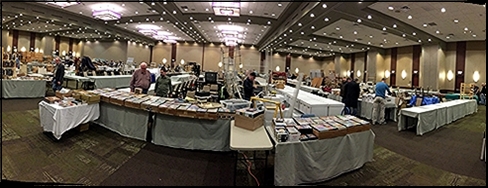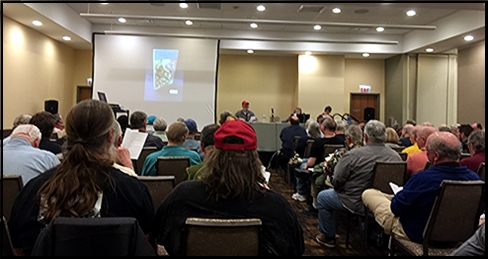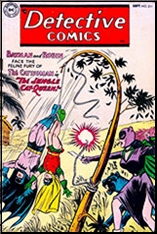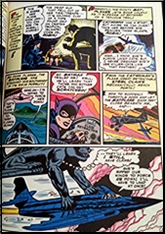WINDY CITY PULP CONVENTION 2019 REPORT
by Walker Martin
Next year will be the 20th anniversary of this great convention, and it seems to just be getting better and better. Everyone looks middle-aged or older, so there has to be a point where attendance declines, but it has not occurred yet. This year there were over 120 dealers, 180 tables, and over 500 in attendance. The dealer’s room was expanded and it was an amazing sight to see almost 200 tables crammed with piles of pulps, vintage paperbacks, slicks, first edition books, DVDs, original artwork, and just about every type of pulp related collectible that you could imagine. A heavenly sight for bibliophiles and art lovers!
It’s beyond me how Doug, Deb, and John Gunnison manage to organize this show each year. Plus Doug and Deb manage to host a Thursday pre-convention brunch at their home for art lovers. I would like to thank everyone on the convention committee and staff for a job well done as usual.

The auction this year was even better than usual with hundreds of lots from the Robert Weinberg and Glenn Lord estates. Held on Friday and Saturday the auction started at 8:15 each night and lasted to around midnight. It’s a puzzle to me how John Gunnison manages to handle 400 lots over 8 or so hours. His voice doesn’t fade and he keeps his sense of humor. Somehow his wife, Maureen, and Deb Fulton keep track of each lot and the accounting details. Here are some of highlights:
RAILROAD MAN’S MAGAZINE–two issues from 1918. Despite the title this pulp was a general fiction magazine and is extremely rare. Both issues went for $50 each.
WT letter to author Greye La Spina signed by Farnsworth Wright with his full signature. Due to Parkinson’s disease he soon stopped signing.—$525
Greye La Spina file of excerpts from THRILL BOOK, including a cover to THRILL BOOK from 1919. Too Bad the author didn’t keep the entire magazines because then the lot would have went for thousands of dollars instead of only $100.
WEIRD TALES, Canadian editions—There were several of these interesting issues which had different covers from the American edition. They all went for around $100 each except for one HPL issue which got $700.
ORIENTAL STORIES–nicely bound.—$475
WEIRD TALES–Many issues went for hundreds of dollars but several went for over a thousand, such as 2/24, 3/24, 12/32(first Conan story-$2500), 3/23(first issue–$3750), 9/23, 7/25( Howard’s first story–$1200).
The Case Against The Comics by Gabriel Lynn–Early 1944 pamphlet advocating censorship of comics. Very scarce–$3750
NOT AT NIGHT edited by Herbert Asbury, 1928. Signed by Asbury, Lovecraft, and Derleth—$4500
A MIDSUMMER NIGHT’S DREAM. The only volume in Wright’s Shakespeare Library. 25 illustrations by Finlay.–$425. I wanted this to go along with my WT set but I chickened out too early.
Errata sheet for “The Shadow Over Innsmouth” by HPL–$1500
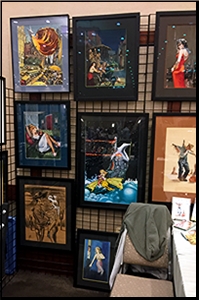
Daisy Bacon signed letter from 1945. This did not go for much over a hundred but I must have fallen asleep during the bidding. I wanted it as an example that Daisy edited DETECTIVE STORY magazine in the forties and not just LOVE STORY. A tell all book will soon be out titled QUEEN OF THE PULPS by Laurie Powers(who some of us also consider The Queen of the Pulps).
ACTION STORIES, FIGHT STORIES, COWBOY STORIES–all crammed full of stories by Robert Howard. Prices were all over the place but usually over 100.
World Fantasy Award Statue, 1978. This is Glenn Lord’s which was awarded for his work in editing and publishing Robert Howard. A great image of HPL—$2000. I wanted this to go along with my Walter Baumhofer and Elmer Kelton Guest Of Honor Plaques from Pulpcon. But I dropped out at $2000 weeping bitter tears of disappointment.
AMRA bound set of first 20 issues—$1000. I wanted this since I’m lacking these early issues but I couldn’t convince myself that a 20 page fanzine is worth $50 each.
THE SHUNNED HOUSE by HPL and printed by Paul Cook.$5,500
DUNE by Frank Herbert. First Edition at $1800.
PEOPLE’S FAVORITE MAGAZINE 6/25/19–$950. True HBJ is in this but no way should it bring this price. Ridiculous.
DIME DETECTIVE–30 lots from 1933 through 1935. Most in beautiful condition–Some as low as $80 but many as high as $200 or $300.
There were many other interesting and high bids but the above will give you an idea of the fun and suspense occurring at the auctions.
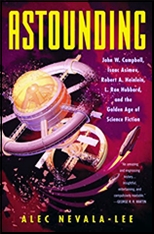
Also of note and almost as interesting as the auction was a talk given on Friday night by Alec Nevala-Lee about his recent excellent book on ASTOUNDING and John W. Campbell. I agree absolutely that Campbell was responsible for The Golden Age of Science Fiction in the forties. Unfortunately he went off the tracks in the fifties with Dianetics, the Dean drive, and the Hieronymus machine. Just my opinion of course but Alfred Bester had a story meeting with Campbell in the early fifties and came away thinking that Campbell was unhinged. I won’t even go into his racial ideas but he was of great influence in magazine SF.
On Saturday night there was a panel on “Remembering PLANET STORIES“. The funny thing is that the audience thought that we had forgotten Planet Stories since we were late in returning from dinner due to slow service at a restaurant. The panel was made up of Ed Hulse, Garyn Roberts and myself. I concentrated on my collection of PLANET and how I ended up with the world’s best condition set (the Frank Robinson issues) and the world’s worst condition set. It’s a story too strange and horrible to repeat but the audience seemed to enjoy it.

Despite my respect for John Campbell I also mentioned on this panel that he seemed to have a major blind spot with certain quality writers. Once he made up his mind that you were not on the same wave length, he often would stop publishing your work. Three of the best PLANET STORIES authors suffered from Campbell’s dislike for example. Ray Bradbury had one early story in ASTOUNDING but had 20 appearances in PLANET STORIES. Leigh Brackett had a couple early stories in ASTOUNDING but also had 20 in PLANET. Philip K. Dick, who has claim to being one of the best and most influential SF writers, had one that I know of with Campbell but five with PLANET, including his first sale. As the fifties and sixties continued this trend became more and more obvious with authors who were once popular in ASTOUNDING in the forties. The found new markets in GALAXY and F&SF.
But if you don’t care for auctions, dealer’s room, or panels, then there are other diversions such as the art show, Ed Hulse’s film program, and the hospitality room. I love the hospitality room where I guzzled many a beer. Not to mention the snacks. There are plenty of great restaurants nearby, and I gained 5 pounds.
The convention also published a book titled WINDY CITY PULP STORIES. This book comes out annually and the 19th edition is 188 pages and edited by Tom Roberts. Tom always does a good job on the book and also is the publisher of Black Dog Books. I hear he had to miss the show this year, and I hope to see him at next year’s event. The best and most interesting article in the book was by Frank Robinson written in 1951 and discussing the likely end of the pulps. Frank shows some interesting circulation figures leading to the decline and end by 1955. (There were a couple of exceptions lasting beyond 1955 like SF QUARTERLY and RANCH ROMANCES.)

Three excellent books from Altus Press made their debut. Though Matt Moring couldn’t make it due to work, the books made it thanks to Mike Chomko. The books are:
1–OPERATOR 5, The Complete Purple Wars. Two volumes with the illustrations which are excellent. It would cost thousands to get the 14 issues in fine condition, so this limited edition is a bargain at $150. Often called The War and Peace of the pulps. WAR AND PEACE is my favorite all time novel, so I’ll be comparing Tepperman with Tolstoy. I wonder who wrote the better novel?
2—SHIPS AND MEN by H. Bedford Jones. Reprinted from BLUE BOOK for the first time.
3–The 2019 issue of the revived BLACK MASK. Matt Moring is doing a great job reviving this great pulp with new and reprinted stories. I urge you all to support this magazine. Copies are available from Altus Press, Mike Chomko, and Amazon.com.
Another excellent book coming out by the end of the year will be QUEEN OF THE PULPS by Laurie Powers. Not only a life of editor Daisy Bacon but a great love story as Daisy carries on a torrid affair while editing LOVE STORY. By the way Daisy also edited DETECTIVE STORY MAGAZINE during the forties, so the book is just not about the romance pulps. McFarland Books has it listed on their website.

What did I get at the show? Well, I don’t need too many pulps any longer and I managed to control my lust for original art but I did find a nice piece of preliminary cover art by Rosen for TEXAS RANGERS, April 1944. The interesting thing is this art was also used as the cover for a Popular Library paperback titled DRYGULCH TRAIL by William Macleod Raine. So in other words the art appeared on two different formats: pulp magazine and paperback.
I also bought a stack of interior illustration proofs. We have all seen cover proofs but illustration proofs are a lot rarer. These came from the estate of Ryerson Johnson, who was a long time writer but also an editor for Popular Publications for a couple years in the forties. He told me as he was leaving on his last day of work, he was encouraged to take whatever art he wanted for free. He ended up taking three cover paintings, many interior drawings, advertising posters, and these illustration proofs.
One of the few auction lots that I was high bidder on turned out to be a nice find. PM #42, dated Feb-March 1938 had a nice article on artist Lee Brown Coye. The cover and many interior illustration are by Coye and give a nice example of his early work,
As usual, I have nothing but good things to say about the convention and the Westin hotel. But surely something must have gone bad, right? I can only think of three things:
1–On the drive to Chicago, we stayed at an inexpensive motel which was like only $60. I guess you get what you pay for because when I got up to take a hot shower to wake me up and loosen my back spasms, the water almost immediately turned cold. I almost jumped through the wall. How can a motel not have hot water?
2–On the ride back we stayed at another motel this time for $80. Unfortunately they had breakfast sausage that looked and smelled horrible. It probably is not a good idea to eat breakfast at inexpensive motels.
3–As we packed the rental van on Sunday, there seemed to be quite a bit of snow. So much in fact that we held a meeting and almost voted to stay over another night and leave the next day. But we decided to leave anyway despite the snow storm and eventually the snow turned to rain.
Next up? Pulpfest! August 15 through August 18, 2019. The hotel is first class like the Westin and details are at pulpfest.com. See you there!
